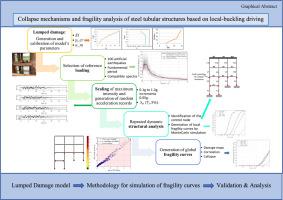基于局部屈曲驱动变量的管状结构脆性分析
IF 7.1
1区 工程技术
Q1 ENGINEERING, MECHANICAL
International Journal of Mechanical Sciences
Pub Date : 2024-10-13
DOI:10.1016/j.ijmecsci.2024.109776
引用次数: 0
摘要
基于性能的地震工程(PBEE)对计算要求很高,因为需要进行多种高保真非线性动态结构响应分析来计算脆性曲线。典型的工程需求参数(EDP)(如楼层漂移或塑性旋转角)无法正确描述管状钢结构的局部屈曲。针对上述两个问题,我们在本手稿中建议使用基于成块损伤力学(LDM)的状态变量来描述 PBEE 中的局部屈曲(LB)。因此,我们为容易因局部屈曲而失效的复杂管状结构的脆性分析提出了一种高效、创新的程序。此外,局部屈曲会导致刚度损失,荷载会转移到完好或损伤较小的构件上。最终,结构会形成整体坍塌机制。在本文中,我们展示了如何确定在随机地震荷载作用下的非对称管状结构中最可能的整体坍塌机制。这包括评估不同构件的损伤指数及其相关性,以及识别更有可能形成整体倒塌机制的 LB 故障组合。构建的脆性曲线描述了单个构件的枸杞溃散起始点以及最有可能的整体坍塌机制。针对一个简单的框架结构,根据实验结果检验了 LB-LDM 模型的准确性。另一个案例研究涉及一个非对称管状码头,说明了如何寻找最可能的整体坍塌机制,并推导出其脆性函数。本文章由计算机程序翻译,如有差异,请以英文原文为准。

Fragility analysis of tubular structures based on local-buckling driving variables
Performance-Based Earthquake Engineering (PBEE) is computationally demanding, due to the multiple high-fidelity nonlinear dynamic structural response analyses required to compute fragility curves. Local buckling of tubular steel structures is not properly characterized by typical Engineering Demand Parameters (EDPs) such as story drifts or plastic rotation angles. Targeting the two issues above, in this manuscript we propose using state variables based on Lumped Damage Mechanics (LDM) to characterize Local Buckling (LB) in PBEE. Hence, we propose an efficient and innovative procedure for the fragility analysis of complex tubular structures prone to fail due to local buckling. Moreover, local buckling produces a loss of stiffness, with loads transferred to intact or to less-damaged elements. Eventually, the structure forms a global collapse mechanism. Herein, we show how to identify the most likely global collapse mechanism in non-symmetrical tubular structures subjected to random seismic loading. This involves evaluating damage indices in different elements and their correlation, as well as identifying the combination of LB failures that are more likely to form a global collapse mechanism. Fragility curves characterizing the onset of LB at individual elements, and the most likely global collapse mechanism, are constructed. A simple frame structure is addressed, where the accuracy of the LB-LDM model is checked against experimental results. Another case study involving a non-symmetric tubular wharf illustrates the search for the most likely global collapse mechanism, and the derivation of its fragility function.
求助全文
通过发布文献求助,成功后即可免费获取论文全文。
去求助
来源期刊

International Journal of Mechanical Sciences
工程技术-工程:机械
CiteScore
12.80
自引率
17.80%
发文量
769
审稿时长
19 days
期刊介绍:
The International Journal of Mechanical Sciences (IJMS) serves as a global platform for the publication and dissemination of original research that contributes to a deeper scientific understanding of the fundamental disciplines within mechanical, civil, and material engineering.
The primary focus of IJMS is to showcase innovative and ground-breaking work that utilizes analytical and computational modeling techniques, such as Finite Element Method (FEM), Boundary Element Method (BEM), and mesh-free methods, among others. These modeling methods are applied to diverse fields including rigid-body mechanics (e.g., dynamics, vibration, stability), structural mechanics, metal forming, advanced materials (e.g., metals, composites, cellular, smart) behavior and applications, impact mechanics, strain localization, and other nonlinear effects (e.g., large deflections, plasticity, fracture).
Additionally, IJMS covers the realms of fluid mechanics (both external and internal flows), tribology, thermodynamics, and materials processing. These subjects collectively form the core of the journal's content.
In summary, IJMS provides a prestigious platform for researchers to present their original contributions, shedding light on analytical and computational modeling methods in various areas of mechanical engineering, as well as exploring the behavior and application of advanced materials, fluid mechanics, thermodynamics, and materials processing.
 求助内容:
求助内容: 应助结果提醒方式:
应助结果提醒方式:


